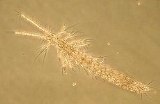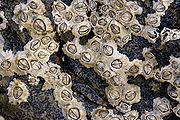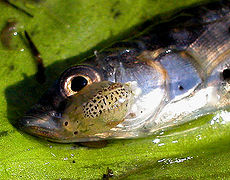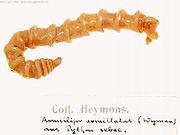
Maxillopoda
Encyclopedia
Maxillopoda is a diverse class
of crustacean
s including barnacle
s, copepod
s and a number of related animals. It does not appear to be a monophyletic group, and no single character unites all the members.
.. They often have short bodies, with the abdomen
reduced in size, and generally lacking any appendage
s This may have arisen through paedomorphosis.
Apart from barnacles, which use their legs
for filter feeding, most maxillopodans feed with their maxilla
e. They have a bauplan comprising 5 cephalic segments, 6 thoracic segments and 4 abdominal segments, followed by a telson
.
, with fossils of both barnacle
s and tongue worms
known from that period.
s among the Maxillopoda. Of the six groups, only Mystacocarida
are entirely free-living; all the members of the Tantulocarida
, Pentastomida
and Branchiura
are parasitic, and many of the Copepod
a and Thecostraca
are parasites.
Class (biology)
In biological classification, class is* a taxonomic rank. Other well-known ranks are life, domain, kingdom, phylum, order, family, genus, and species, with class fitting between phylum and order...
of crustacean
Crustacean
Crustaceans form a very large group of arthropods, usually treated as a subphylum, which includes such familiar animals as crabs, lobsters, crayfish, shrimp, krill and barnacles. The 50,000 described species range in size from Stygotantulus stocki at , to the Japanese spider crab with a leg span...
s including barnacle
Barnacle
A barnacle is a type of arthropod belonging to infraclass Cirripedia in the subphylum Crustacea, and is hence related to crabs and lobsters. Barnacles are exclusively marine, and tend to live in shallow and tidal waters, typically in erosive settings. They are sessile suspension feeders, and have...
s, copepod
Copepod
Copepods are a group of small crustaceans found in the sea and nearly every freshwater habitat. Some species are planktonic , some are benthic , and some continental species may live in limno-terrestrial habitats and other wet terrestrial places, such as swamps, under leaf fall in wet forests,...
s and a number of related animals. It does not appear to be a monophyletic group, and no single character unites all the members.
Description
With the exception of some barnacles, maxillopodans are mostly small, including the smallest known arthropod, Stygotantulus stockiStygotantulus
Stygotantulus stocki is a species of crustacean, living as an ectoparasite on harpacticoid copepods of the families Tisbidae and Canuellidae. It is the smallest arthropod in the world, at a length of less than . The specific epithet stocki commemorates Jan Hendrik Stock, a Dutch carcinologist....
.. They often have short bodies, with the abdomen
Abdomen
In vertebrates such as mammals the abdomen constitutes the part of the body between the thorax and pelvis. The region enclosed by the abdomen is termed the abdominal cavity...
reduced in size, and generally lacking any appendage
Appendage
In invertebrate biology, an appendage is an external body part, or natural prolongation, that protrudes from an organism's body . It is a general term that covers any of the homologous body parts that may extend from a body segment...
s This may have arisen through paedomorphosis.
Apart from barnacles, which use their legs
Arthropod leg
The arthropod leg is a form of jointed appendage of arthropods, usually used for walking. Many of the terms used for arthropod leg segments are of Latin origin, and may be confused with terms for bones: coxa , trochanter , femur, tibia, tarsus, ischium, metatarsus, carpus, dactylus ,...
for filter feeding, most maxillopodans feed with their maxilla
Maxilla
The maxilla is a fusion of two bones along the palatal fissure that form the upper jaw. This is similar to the mandible , which is also a fusion of two halves at the mental symphysis. Sometimes The maxilla (plural: maxillae) is a fusion of two bones along the palatal fissure that form the upper...
e. They have a bauplan comprising 5 cephalic segments, 6 thoracic segments and 4 abdominal segments, followed by a telson
Telson
The telson is the last division of the body of a crustacean. It is not considered a true segment because it does not arise in the embryo from teloblast areas as do real segments. It never carries any appendages, but a forked "tail" called the caudal furca is often present. Together with the...
.
Fossil record
The fossil record of the group extends back into the CambrianCambrian
The Cambrian is the first geological period of the Paleozoic Era, lasting from Mya ; it is succeeded by the Ordovician. Its subdivisions, and indeed its base, are somewhat in flux. The period was established by Adam Sedgwick, who named it after Cambria, the Latin name for Wales, where Britain's...
, with fossils of both barnacle
Barnacle
A barnacle is a type of arthropod belonging to infraclass Cirripedia in the subphylum Crustacea, and is hence related to crabs and lobsters. Barnacles are exclusively marine, and tend to live in shallow and tidal waters, typically in erosive settings. They are sessile suspension feeders, and have...
s and tongue worms
Pentastomida
Pentastomida are an enigmatic group of parasitic invertebrates commonly known as tongue worms due to the resemblance of the species of the genus Linguatula to a vertebrate tongue....
known from that period.
Classification
Six subclasses are generally recognised, although many works have further included the ostracodOstracod
Ostracoda is a class of the Crustacea, sometimes known as the seed shrimp because of their appearance. Some 65,000 species have been identified, grouped into several orders....
s among the Maxillopoda. Of the six groups, only Mystacocarida
Mystacocarida
Mystacocarida is a subclass of crustaceans, that form part of the meiobenthos. They are less than long, and live interstitially in the intertidal zones of sandy beaches.-Taxonomy:...
are entirely free-living; all the members of the Tantulocarida
Tantulocarida
Tantulocarida is a highly specialised group of parasitic crustaceans that consists of about 33 species, treated as a subclass of the class Maxillopoda . They are typically ectoparasites that infest copepods, isopods, tanaids, amphipods and ostracods...
, Pentastomida
Pentastomida
Pentastomida are an enigmatic group of parasitic invertebrates commonly known as tongue worms due to the resemblance of the species of the genus Linguatula to a vertebrate tongue....
and Branchiura
Branchiura
The family Argulidae contains the carp lice or fish lice – a group of parasitic crustaceans of uncertain position within the Maxillopoda. Although they are thought to be primitive forms, they have no fossil record...
are parasitic, and many of the Copepod
Copepod
Copepods are a group of small crustaceans found in the sea and nearly every freshwater habitat. Some species are planktonic , some are benthic , and some continental species may live in limno-terrestrial habitats and other wet terrestrial places, such as swamps, under leaf fall in wet forests,...
a and Thecostraca
Thecostraca
Thecostraca are a subclass of marine invertebrates containing about 1,320 described species. Many species have planktonic larvae which become sessile or parasitic as adults....
are parasites.
| Subclass | Members | Photo |
|---|---|---|
| Copepod Copepod Copepods are a group of small crustaceans found in the sea and nearly every freshwater habitat. Some species are planktonic , some are benthic , and some continental species may live in limno-terrestrial habitats and other wet terrestrial places, such as swamps, under leaf fall in wet forests,... a |
Calanoida Calanoida Calanoida is an order of copepods, a kind of zooplankton. They include around 40 families with about 1800 species of both marine and freshwater copepods. Calanoid copepods are dominant in the plankton in many parts of the world's oceans, making up 55%–95% of plankton samples... Cyclopoida Cyclopoida Cyclopoida is an order of small crustaceans from the subclass Copepoda. Like many other copepods, members of Cyclopoida are small, planktonic animals living both in the sea and in freshwater habitats. They are capable of rapid movement... Gelyelloida Harpacticoida Harpacticoida Harpacticoida is an order of copepods, in the Subphylum Crustacea. This order comprises 463 genera and about 3,000 species. Members of it are benthic copepods found throughout the world in the marine environment and in fresh water... Misophrioida Monstrilloida Monstrilloida Monstrilloida is an order of copepods with a cosmopolitan distribution in the world's oceans. The order contains a single family, Monstrillidae; the family Thaumatopsyllidae was formerly included in the order, but is now usually placed in the Cyclopoida... Mormonilloida Platycopioida Poecilostomatoida Poecilostomatoida Poecilostomatoida are an order of copepods previously included in the Cyclopoida.-Description:The classification of these copepods has been established on the basis of the structure of the mouth. In poecilostomatoids the mouth is represented by a transverse slit, partially covered by the... Siphonostomatoida Siphonostomatoida Siphonostomatoida are copepods of the order of the subclass Maxillopoda, inside the subphylum Crustacea. There are 42 recognised families:*Amaterasidae*Archidactylinidae*Artotrogidae*Asterocheridae*Brychiopontiidae*Caligidae*Calverocheridae... |
Calocalanus pavo Calocalanus pavo Calocalanus pavo is a species of copepod in the family Calocalanidae.... (Calanoida Calanoida Calanoida is an order of copepods, a kind of zooplankton. They include around 40 families with about 1800 species of both marine and freshwater copepods. Calanoid copepods are dominant in the plankton in many parts of the world's oceans, making up 55%–95% of plankton samples... : Calocalanidae) |
| Thecostraca Thecostraca Thecostraca are a subclass of marine invertebrates containing about 1,320 described species. Many species have planktonic larvae which become sessile or parasitic as adults.... |
Cirripedia Barnacle A barnacle is a type of arthropod belonging to infraclass Cirripedia in the subphylum Crustacea, and is hence related to crabs and lobsters. Barnacles are exclusively marine, and tend to live in shallow and tidal waters, typically in erosive settings. They are sessile suspension feeders, and have... (barnacles) Facetotecta Facetotecta Facetotecta is a poorly known infraclass of thecostracan crustaceans. The adult forms have never been recognised, and the group is known only from its larvae, the "y-nauplius" and "y-cyprid" larvae... Ascothoracida Ascothoracida Ascothoracida is a small group of crustaceans, comprising around 100 species. They are found throughout the world, and are parasites on cnidarians and echinoderms.... |
 Chthamalus stellatus Chthamalus stellatus Chthamalus stellatus, common name Poli's stellate barnacle, is a species of acorn barnacle common on rocky shores in South West England, Ireland, and Southern Europe. It is named after Giuseppe Saverio Poli.-Description:... (Sessilia Sessilia Sessilia is an order of barnacles, comprising the barnacles without stalks, or acorn barnacles. They form a monophyletic group and are probably derived from stalked barnacles. The order is divided into three suborders. Brachylepadomorpha contains a single family, Neobrachylepadidae, while... : Chthamalidae Chthamalidae Chthamalidae is a family of barnacles of the order Sessilia, containing the following genera:*Chinochthamalus Foster, 1980*Chthamalus Ranzani, 1817*Euraphia Conrad, 1837*Nesochthamalus Foster & Newman, 1987... ) |
| Branchiura Branchiura The family Argulidae contains the carp lice or fish lice – a group of parasitic crustaceans of uncertain position within the Maxillopoda. Although they are thought to be primitive forms, they have no fossil record... |
Arguloida (fish lice) † Cyclida Cyclida Cyclida is an order of fossil arthropods that lived from the Carboniferous to the Jurassic... |
 Argulus on a stickleback Stickleback The Gasterosteidae are a family of fish including the sticklebacks. FishBase currently recognises sixteen species in the family, grouped in five genera. However several of the species have a number of recognised subspecies, and the taxonomy of the family is thought to be in need of revision... (Argulidae) |
| Pentastomida Pentastomida Pentastomida are an enigmatic group of parasitic invertebrates commonly known as tongue worms due to the resemblance of the species of the genus Linguatula to a vertebrate tongue.... (tongue worms) |
Cephalobaenida Porocephalida |
 Armillifer armillatus Armillifer armillatus Armillifer armillatus is a species of Armillifer that can cause porocephalosis in humans.... (Porocephalidae) |
| Mystacocarida Mystacocarida Mystacocarida is a subclass of crustaceans, that form part of the meiobenthos. They are less than long, and live interstitially in the intertidal zones of sandy beaches.-Taxonomy:... |
Ctenocheilocaris Derocheilocaris |
 Ctenocheilocaris (Derocheilocarididae) |
| Tantulocarida Tantulocarida Tantulocarida is a highly specialised group of parasitic crustaceans that consists of about 33 species, treated as a subclass of the class Maxillopoda . They are typically ectoparasites that infest copepods, isopods, tanaids, amphipods and ostracods... |
Basipodellidae Deoterthridae Doryphallophoridae Microdajidae |

